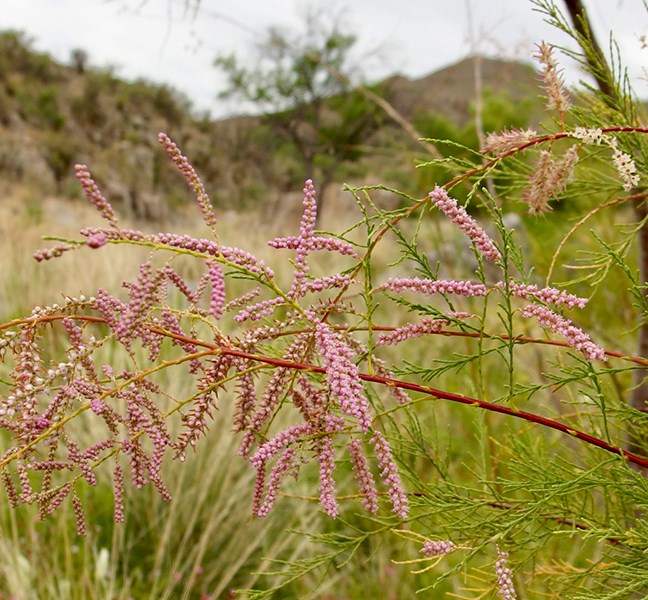Last updated: September 1, 2022
Article
Invasive Exotic Plant Monitoring at Capitol Reef National Park, 2019 Field Season

Monitoring in 2019 found relatively few invasive exotic plant species, with low overall percent cover. But tamarisk showed a marked increase from past years, as previously identified infestations have grown larger.
What Are Invasive Exotic Plants?
Invasive exotic plants (IEPs) are non-native species whose introduction to an environment causes (or is likely to cause) economic or environmental harm, or harm to human health. IEPs can alter ecosystems at multiple scales—threatening wildlife, natural landscapes, and recreational opportunities. They can reproduce prolifically, rapidly colonize new areas, and displace native species.
Invasive plants fill different ecological roles than the native plants they replace. As a result, the needs of species that depended on the native vegetation may go unmet, potentially creating a cascade of ecological effects.
The good news is that if discovered before they have a chance to take hold, IEP populations can be eradicated from parks. Small populations are cheaper and easier to control than large populations. Therefore, early detection is critical.
What Can Be Done?
To provide early warning of weed invasions and help park managers prioritize control efforts, the Northern Colorado Plateau Network (NCPN) monitors invasive exotic plants in eight National Park Service units. First, network and park staff create a list of priority IEPs for each park. Then, on a rotating schedule, a field crew looks for those IEPs along established monitoring routes. Along the routes, they stop and set up plots for additional data collection. The plot data allow network ecologists to estimate trends over time.
During data analysis, a Patch Management Index (PMI) helps identify the scale of the problem presented by each patch of exotic plants. PMI multiplies the size of each patch by the amount of each patch that is covered in weeds to arrive at a composite score. The PMI score is assigned to a class, ranging from very low to very high.
To be useful, PMI must be considered in combination with species and patch numbers. In many cases, targeting patches with very low or low PMI allows managers to keep small patches from growing into bigger problems. On the other hand, a species with many patches of very low or low PMI may be harder to treat than a different species with just a few patches of high or very high PMI.
Recent Monitoring at Capitol Reef National Park

IEP monitoring at Capitol Reef NP is done on a four-year rotation of monitoring routes at that cover Highway 24, the Pleasant Creek cattle trail, Oak Creek cattle trail, the Scenic Drive, and Cathedral Valley Road. In 2019, NCPN staff visited the Scenic Drive and Cathedral Valley Road routes for the third time. During monitoring on May 30–June 1, 2019, a total of 122 patches of 10 different IEP species were recorded along 34 kilometers (21 mi) of two monitoring routes and in 66 transects at Capitol Reef National Park (see table). Of these, six were priority species that accounted for 119 separate patches. The vast majority (93.2%) of priority patches ranked either low or very low on the patch management index scale, suggesting that effective control or eradication is possible through local management actions. Cathedral Valley Road had more priority patches per kilometer than the Scenic Drive.
Tamarisk (Tamarix sp.) was the most prevalent priority species along the monitored routes. The 72 patches recorded represent a marked increase from previous monitoring years. The size of patches also increased dramatically; along Cathedral Valley Road, 87% were in the largest size class (1,000–2,000 m2) (see map). This indicates that previously identified infestations have expanded and grown.
Cheatgrass (Bromus tectorum) and Russian thistle (Salsola sp.) are so widespread that they are not recorded along routes—but are monitored in transects. Russian thistle was present in 33.3% of transects, and has increased in frequency since 2012. However, its percent cover (0.2%) remains low. Cheatgrass was found in just 3% of transects in 2019.
| Scientific name | Common name | Patches |
|---|---|---|
| Tamarix sp.* | tamarisk | 72 |
| Malcolmia africana* | African mustard | 32 |
| Convolvulus arvensis* | field bindweed | 9 |
| Elaeagnus angustifolia* | Russian olive | 3 |
| Chorispora tenella | blue mustard | 2 |
| Ulmus pumila* | Siberian elm | 2 |
| Elymus repens* | quackgrass | 1 |
| Sisymbrium altissimum | tumble mustard | 1 |
| Total | -- | 122 |
*Priority species

Management Recommendations
We recommend that the Scenic Drive and Cathedral Valley Road be prioritized for exotic species control to help prevent further increases in the size and number of IEP patches.
Prioritizing treatment of small-scale IEP patches can prevent future spread and allow eradication. But the large number of tamarisk patches with very low and low PMI indicates the species is sparsely scattered across a broad landscape, and controlling it will mean travel across broad areas. Managers can consider species traits (e.g., how likely and quickly plants may spread) and environmental conditions (precipitation and temperature), and combine this information with patch numbers and PMI values when determining treatment priorities.
The NCPN plans to return to Capitol Reef in 2020 to monitor Oak and Pleasant creeks, completing the third rotation of invasive plant monitoring.
For more information, see K. Fahey and D. W. Perkins, Invasive Exotic Plant Monitoring in Capitol Reef National Park: 2019 Field Season.
